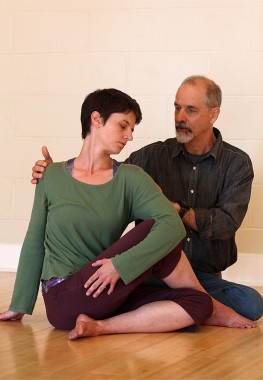Gary Kraftsow ’76
In the 1970s, Gary Kraftsow ’76 was working toward his PhD in religious studies at the University of California when his longtime yoga teacher, the renowned T.K.V. Desikachar, told him, “You should study medicine.” Confused, Kraftsow, who had majored in religion at Colgate and was certain of his interests, asked why. Desikachar predicted, “You’re going to bring yoga therapy into the context of Western health care.”
Today, Kraftsow, the founder and director of the American Viniyoga Institute in Oakland, Calif., has been at the forefront of yoga therapy for four decades. In addition to helping private clients, he trains yoga teachers and yoga therapists through the institute. He also teaches at national conferences and workshops around the country.
“In Sanskrit, the prefixes of ‘vi’ and ‘ni,’ combined with ‘yoga,’ mean that you differentiate, adapt, and apply appropriately,” he said. “The tools of yoga practice need to be adapted to suit the needs of the individual practitioners.”
Emphasizing that yoga is not a replacement for, but rather a complement to, medical care, Kraftsow said that “yoga has tremendous benefits to offer. Our role as yoga therapists is to train individuals in how they can manage their symptoms. In some cases, we eliminate or reduce some symptoms, and in others, we help them manage their symptoms and cope with their conditions.”
For example, with patients who have cancer, “there’s a big psychosocial and psycho-emotional impact,” Kraftsow explained. “Part of our work is saying to them, ‘You’re not your diagnosis; you’re not cancer,’ and then helping them to improve sleep, increase energy, balance stress, and make them feel better.”
Over the years, Kraftsow has assisted with several studies about the effects of yoga. His role has been to design an intervention, which is a specific yoga practice or group of practices, for the studies’ 12-week periods. The first study, funded by the National Institutes of Health and published in the Annals of Internal Medicine, showed that yoga can alleviate chronic back pain. Kraftsow also helped with a Wayne State University study on the effects of yoga practice on patients with lung cancer. “We’re not talking about eliminating the cancer, but about helping to improve their breathing and quality of life,” he said. “Most of the pharmaceuticals that are prescribed for chronic diseases are sympathetic/parasympathetic activators, and [similarly] the breathing is like a sympathetic/parasympathetic activator.”
Several studies have also been conducted by the insurance company Aetna, whose CEO worked closely with Kraftsow. Mark Bertolini was interested in facilitating a study on stress, so he funded it himself and recruited his employees. The study proved to be statistically significant, and the American Viniyoga Institute now has teachers leading stress-management classes in more than 30 Aetna locations around the United States.
As his mentor predicted, Kraftsow has brought ancient Indian principles to Western health care. He learned yoga during his first year at Colgate when he signed up for a class to fulfill the physical education requirement. Mary Lou Skelton, wife of Professor Bill Skelton, taught the class. Six months later, Kraftsow was in India with the study group led by the Skeltons. Through them, he was introduced to Tirumalai Krishnamacharya — “the father of modern yoga” — and his son Desikachar.
“I got in on the ground floor,” Kraftsow said. “I was nineteen when I got involved with yoga, and there wasn’t much going on. But over the years, the community has grown all around me.”
— Aleta Mayne







